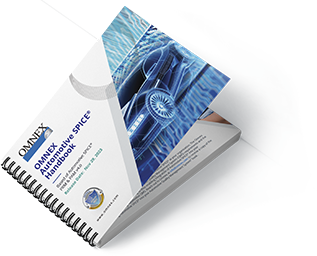Navigating the Future: Transitioning to eMobility and Hybrids
The future of transportation is eMobility and Hybrids. In preparation, the automotive industry is in a transitional period from Gasoline and Diesel Vehicles to Electric and Autonomous Vehicles (EV and AV). Certain economic and market factors have led to the transition, but it is clear that this change is here to stay. This shift from mechanical products with combustion engines to mechatronic and electronic products with electric power has significant implications to OEMs and Tier Ones. If you are not a part of the change, you may not have a future in the Automotive and Truck Industry. Organizations will have to shift their product development strategy from mechanical design to a focus on System, Hardware, and Software. To navigate this transition Omnex recommends the 7 Levers strategy.
Omnex Automotive SPICE Handbook –
Based on Automotive SPICE PRM & PAM v4.0
Grab your free pocket-sized copy of the Automotive SPICE Handbook from Omnex.
Note: Shipping charges apply.
Click here for your free copy.

7 LEVERS
Autonomous Vehicles and Electric Vehicles referred widely as simply "AV or EV" requires a high degree of functional safety and cyber-security checks. The addition of new electronics, hardware and software components introduce new risks, some that are multi-point failures. Several standards and quality management tools address system, software, and hardware elements of the fast-changing EV-AV product.
As per a safety study conducted by Omnex, Active Safety and ADAS technology have improved safety but not reduced the customer issues on the road. Breakdown happens more than ever. This is also because newer vehicles come with more complexity and becoming difficult to fix issues in the absence of an expert mechanic. Therefore, the importance of designing and developing an autonomous vehicle largely requires the application of tools to help companies stay organized and up to the quality standards. In addition to the product complexity, the EV and AV data including hardware and software has grown tremendously. Up to 50% of the vehicle content will be digitalized, as hardware and software by 2030. Additionally, software failures in warranty recalls have increased from 15% in 2016 to a reported 50% for certain OEMs.
To navigate the complex and ever-evolving EV-AV process, Omnex recommends the 7 Levers strategy. We find these levers to be essential, as they assist throughout the New Product Development process, from the concept phase all the way through to the end of life and decommissioning of the product. The 7 Levers strategy assist in re-assessing product strategy, taking care to account for the complex System, Hardware and Software Components in a Safety Product, and Electric and Autonomous Vehicle Systems. These seven major standards/best practices governing the Automotive Industry are all linked with each other and Omnex has defined these 7 Levers strategy (including Supply Chain, a set of best practices) with over 30 years of experience assisting large automotive companies worldwide. Implementation of these levers will ensure that your system will have Quality, Safety, and Security in all the product lifecycles, particularly in its design and launch.
Featured Insights View all resources
How Can We Help You
For any service request or to seek consulting, Our Customer Service Team is ready to serve you, round the clock.








